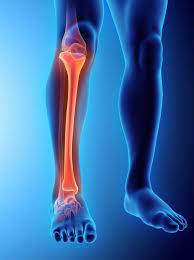What to Expect After Suffering a Fractured Tibia?

If you have fractured your tibia, it is entirely normal to feel stressed and worried about what will happen next. By all means, suffering any severe injury can be scary and cause feelings of frustration and anxiety. While there is no magic trick to eliminate these feelings, here is some valuable information to help get back your piece of mind.
What is the Tibia?
Two bones make up our lower leg, the tibia and the fibula. The tibia or shinbone is the bigger of the two. Unfortunately, the tibia is also one of the most commonly fractured bones in the body. Symptoms from a fractured tibia can range from swelling and bruising to intense pain in your lower leg, depending on the severity of the fracture. To diagnose this injury, your doctor will perform a physical exam and may run some tests to get an image of the fracture. Your doctor may also recommend surgery, depending on what type of tibia fracture you experience. Recovery time also may vary depending on how bad the fracture is.

Symptoms
Depending on the type and extent of the fracture, symptoms will vary. However, intense pain in the lower leg is a symptom reported in almost all situations. In addition, you will likely have difficulty walking, numbness or tingling in your foot, and be unable to bear weight on the injured leg. You may also notice deformity in your lower leg, where the fracture is located, and in severe cases, the bone may even protrude and break through the skin. It is also not uncommon for the fibula to be affected when the tibia is fractured.
Diagnosis
If you suspect you have fractured or broken your tibia, your doctor will first ask about your symptoms and any specific incident that could have caused it. They will also go over your medical history to see if you have any risk factors due to prior injury. Then, they will perform a physical examination to look for bruising and deformities and any associated damage to your fibula. After that, your doctor may order imaging tests like an X-ray or CT scan to determine the precise location and type of break. Surgery is not always required, but emergency surgery could be necessary if the fracture is very severe, the bone penetrates the skin, there is nerve damage, or there is more than one break.
Treatment
There are several factors that your doctor will consider when treating a tibial fracture. First, they will assess the injury’s severity, the cause, and one’s overall health and medical history. In less severe cases, surgery isn’t needed. Nonsurgical treatment involves immobilization with a cast or splint, pain medications, and physical therapy. However, surgery may be necessary if the injury is more severe or complex. There are two types of surgical treatment methods. Internal fixation uses screws, rods, and plates to hold the tibia together. External fixation connects screws or pins in the fracture to a metal bar outside your leg for extra support. Surgical treatment is typically accompanied by physical therapy and pain medications. Recovery time varies depending on the extent of the injury but usually takes four to six months. Unfortunately, tibia fractures are a painful and common injury. If you suspect you have a fracture, seek medical attention immediately.
Featured Clinician: Anthony Maritato, PT
FEATURED CLINICIAN: Anthony Maritato, PT Anthony Maritato, PT, MSPT, is a licensed physical therapist and co-founder of Total Therapy Solutions, a private practice outpatient physical therapy business that focuses on
Colleen Rapp Wins Friend of Private Practice Award
Long time patient advocate, Colleen Rapp, was awarded the APTA Private Practice Section’s Friend of Private Practice Award during the 2022 PPS conference. Colleen has long been standing up for
Top Tips for Relieving Nerve Pain
Top Tips for Relieving Nerve Pain If you suffer from nerve or neuropathic pain, then you can certainly attest to how it can throw a wrench in your day-to-day routine.
How Your Diet Can Cause Inflammation
How Your Diet Can Cause Inflammation Depending on the situation, inflammation can be a good thing or a bad thing. It is good in that it is your body’s way
What to Avoid After Knee Replacement Surgery
What to Avoid After Knee Replacement Surgery Knee arthroplasty, otherwise known as knee replacement surgery, is designed to relieve pain and restore function in severely diseased knee joints. No matter
How Physical Therapy Can Help You Avoid Reliance on Pain Medications
How Physical Therapy Can Help You Avoid Reliance on Pain Medications If you suffer from chronic pain, you know how managing pain can be a real challenge. Another day, another
Kyle Yancey
Latest posts by Kyle Yancey (see all)
- Top Tips for Relieving Nerve Pain - October 28, 2022
- How Your Diet Can Cause Inflammation - October 25, 2022
- What to Avoid After Knee Replacement Surgery - October 19, 2022
- How Physical Therapy Can Help You Avoid Reliance on Pain Medications - October 13, 2022
- Physical Therapy for Heart Disease - October 11, 2022
